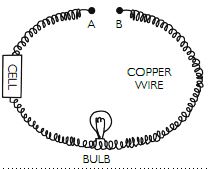Question 1:
Explain why some fibres are called synthetic.
Answer:
Some fibres are called synthetic because they are made by human beings. The raw materials used for preparing synthetic fibres are petrochemicals.
Question 2:
Rayon is different from synthetic fibres because:
- It has a silk-like appearance.
- It is obtained from wood pulp.
- Its fibres can also be woven like those of natural fibres.
Answer:
It is obtained from wood pulp.
Question 3:
Synthetic fibres are also called __________ or __________ fibres.
Answer:
Man-made, artificial
Question 4:
Synthetic fibres are synthesised from a raw material called __________.
Answer:
Petrochemicals
Question 5:
Like synthetic fibres, plastic is also a __________.
Answer:
Polymer
Question 6:
Give examples which indicate that nylon fibres are very strong.
Answer:
Parachutes, ropes used for mountain climbing and tents are made of nylon and this indicates that nylon fibres are very strong.
Question 7:
Explain why plastic containers are favoured for storing food.
Answer:
Plastic containers are favoured for storing food because:
a) Plastic does not react with food, air or water.
b) Plastic is strong and light weight.
c) Plastic containers come in many different sizes, shapes and colours.
Question 8:
Explain the difference between thermoplastic and thermosetting plastics.
Answer:
Question 9:
Explain why the following are made of thermosetting plastics.
(a) Saucepan handles (b) Electric plugs/switches/plug boards
Answer:
(a) Saucepan handles are made of thermosetting plastics because thermosetting plastic is a bad conductor of heat and does not deform on heating.
(b) Electric plugs/switches/plug boards are made of thermosetting plastic because thermosetting plastic is a bad conductor of electricity and hence, reduces the risk of an electric shock.
Question 10:
Categorise the materials of the following products into ‘can be recycled’ and ‘cannot be recycled’. Telephone instruments, plastic toys, cooker handles, carry bags, ballpoint pens, plastic bowls, plastic covering on electrical wires, plastic chairs, electrical switches
Answer:
Can be recycled: Plastic toys, carry bags, ballpoint pens, plastic bowls, plastic chairs
Cannot be recycled: Telephone instruments, cooker handles, plastic coverings on electric wires, electrical switches
Question 11:
Rana wants to buy shirts for summer. Should he buy cotton shirts or shirts made from synthetic material? Advise Rana, giving your reason.
Answer:
Rana should buy cotton shirts because cotton has pores that let the air in and out. On the other hand, synthetic fabrics are very tightly woven and hence, they do not allow air to pass in and out. Cotton clothes soak sweat and give a dry feeling, while synthetic clothes have little water absorbing property.
Question 12:
Give examples to show that plastics are non-corrosive in nature.
Answer:
Plastics do not react with air and water and hence, they do not corrode. Plastics do not decompose when left in the open for long. For example, water is kept in plastic bottles, pickles and food items are stored in plastic containers because the bottles or the containers do not corrode.
Question 13:
Should the handle and bristles of a tooth brush be made of the same material? Explain your answer.
Answer:
No, different materials should be used for making handles and bristles of a toothbrush because bristles help in cleaning the teeth and the handle is just to support them. Bristles must be soft, delicate and should be designed to clean teeth well, while the handle should be hard and rigid.
Question 14:
‘Avoid plastics as far as possible’. Comment on this advice.
Answer:
Plastics are not environment friendly. They release poisonous gases on burning. They are non-biodegradable and hence, pollute soil, water and air. Animals choke on swallowing polythene bags and die. Polythene bags also clog the drains. Therefore, use of plastic should be avoided as far as possible.
Question 15:
Match the terms of column A correctly with the phrases given in column B.
- Polyester
- Teflon
- Rayon
- Nylon
Answer:
(i). (d), (ii). (c), (iii). (a), (iv). (b)
Question 16:
‘Manufacturing synthetic fibres is actually helping in conservation of forests’. Comment.
Answer:
Natural fibres are obtained from natural resources, i.e., plants and animals. On the other hand, synthetic fibres are made from petrochemicals and not from forests or plants. Thus, for manufacturing synthetic fibres we do not need to cut trees or use products obtained from animals.
Question 17:
Describe an activity to show that thermoplastic is poor conductor of electricity.
Answer:
Take a few items made of thermoplastics such a piece of PVC pipe and a toy. Now set up the circuit as shown in the given illustration and one by one insert the thermoplastic item between the terminals A and B. If the bulb starts glowing, then the item is a good conductor of electricity. Otherwise it is a bad conductor of electricity. You would find that the bulb would not glow with any of the items made of thermoplastics. This indicates that thermoplastics are bad conductors of electricity.


